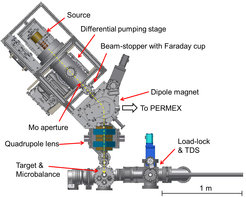New High Current Source „SIESTA“ for Materials Research in Operation
After about 40 years of operation IPP’s old high current ion source, an experiment for investigating plasma-surface processes, was taken out of service. The successor experiment „SIESTA“ has now successfully started operation.
The former IPP High Current Ion Source for the investigation of Plasma-Surface-Interaction processes, which was the basic instrument for about 200 publications during the last 40 years, was decommissioned in the end of 2015. During this time it was dominantly used to measure erosion processes und retention of hydrogen in fusion-relevant materials.

The construction of the follow-up experiment was started at another site a bit earlier. The concept of the new device follows closely the former one, but includes some improvements.
The first plasma in SIESTA (Second Ion Experiment for Sputtering and TDS Analysis) was ignited in February 2016. After about 2 years of thorough characterisation and optimisation SIESTA (see figure) is now ready for routine operation. Thanks to the installation of a magnetic quadrupole lens (the most significant improvement compared with the predecessor) the reachable ion current at the target is higher by about a factor of 4.
A basic description of the experimental set-up and characterisation of SIESTA was recently published in ‚Review of Scientific Instruments‘:
R. Arredondo et al., “SIESTA: A High Current Ion Source for Erosion and Retention Studies”, Review of Scientific Instruments, 89, 103501 (10pp) (2018). doi: 10.1063/1.5039156
Link: https://aip.scitation.org/doi/10.1063/1.5039156
The article was selected as “Editors Pick” in „Review of Scientific Instruments”.
